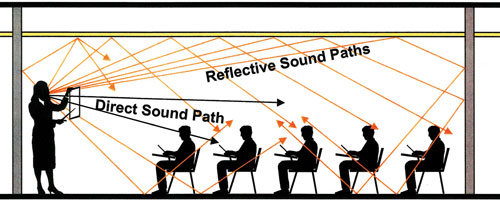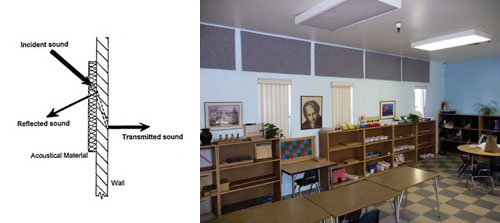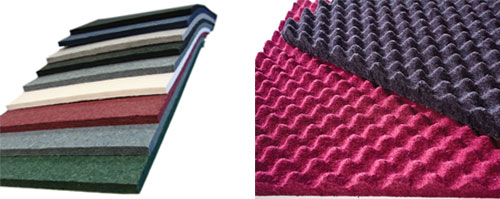Whole System Acoustical Treatments
Reverberation Time
Once the issue of background noise level is addressed by limiting the airborne and structure borne transmission of sound in a space, then a second significant item needs attention. Both LEED for Schools and ANSI Standard S12.60-2002 require that the Reverberation Time (RT) of sound within spaces is also controlled. Sound reflections are created when noise reverberates and echoes around architectural spaces. RT is the acoustical concept which measures how long, in seconds, it takes for these noises to become inaudible. This is quite a significant item since the selection of materials in the space are the direct cause of the reverberation and echoes, typically because their surfaces are hard and sound reflective rather than softer and absorptive. These echoes can impair what acoustical specialists call “speech intelligibility” since the echoes create garbled sounding words and impair verbal communication. Measuring Reverberation Time is important to determine the sound quality of speech and music in acoustical spaces. Instructional spaces, such as classrooms, are best with short RTs – less than 1 second to ensure clarity and high speech intelligibility. Speech generated in a space with a reverberation time of longer than 0.6 seconds is considered difficult to understand. Although some reverberation within a space can aid in speech distribution, longer reverberation times will cause a build-up of noise and thus degrade speech intelligibility. Auditoriums, theaters, and other musical spaces will typically benefit from longer RTs, typically greater than 1.5 seconds.
RT is determined by looking at both the volume and absorption rate in an acoustical space. The volume of a space is proportional to the RT of that space; the greater the volume, the longer the RT. Inversely, the amount of sound-absorbing material in any space will have a negative effect on the RT. As an example, a large space with tiled floors and a drywall ceiling will have a long RT. Conversely, a small room with a low suspended ceiling and high-pile carpet will have a much shorter RT.
Reverberation The time it takes for reflected sound to die down by 60 decibels from the cessation of the original sound signal (measured in seconds). |
 |
In occupied space, the Reverberation Time affects the ability of people to understand spoken words (speech intelligibility) or hear other sounds clearly. Illustration courtesy of Acoustical Surfaces, Inc. |
It is possible to calculate the reverberation time of sound within a space based on the interior surface qualities of a room. Using the process identified in ANSI S12.60-2002 to conduct these calculations, the resulting educational spaces must meet the following levels in order to comply:
• The maximum reverberation time for core learning spaces with internal volumes of greater than 10,000 cubic feet should not exceed 0.6 seconds.
• For core learning spaces with internal volumes of more than 10,000 but less than 20,000 cubic feet, the maximum reverberation time is 0.7 seconds.
• Reverberation time for spaces with more than 20,000 cubic feet of internal volume is not specified, however, guidelines are given in Annex C of the standard.
If an existing space or room is being investigated, then it can be tested with acoustical equipment specifically intended for measuring RT. For a new space, calculations must be relied on to determine what the RT will be in the proposed new or renovated space.
A recent study looked at classroom reverberation and children's performance and well-being in a set of classrooms in Denmark (Klatte et al, 2011). In classrooms with different RTs, they compared the children's short-term memory, speech perception abilities and attitudes about their classrooms and teachers. They compared classrooms with RTs from 0.49 to 1.1 seconds (the ANSI standard calls for a maximum of 0.6 as stated above) and found a significant negative impact on short-term memory and speech perception as reverberation time increased.
 |
The amount of reflected sound compared to transmitted sound is directly related to the absorptive qualities of the acoustical material used in a room. Acoustic panels on this classroom wall help reduce echoes. Drawing and photo courtesy of Acoustical Surfaces, Inc. |
Directly related to RT is the amount of sound energy absorbed upon striking a particular surface. The more sound energy that is absorbed then the less that is reflected back as an echo or reverberation. The commonly used scale to record different levels of such sound absorption is a Noise Reduction Coefficient (NRC) which ranges from zero to one: an NRC of 0 indicates perfect reflection while an NRC of 1 indicates perfect absorption. In actuality, it is the average of four sound absorption coefficients of the particular surface at specific frequencies of 250 Hz, 500 Hz, 1000 Hz, and 2000 Hz. These are the typical frequencies of human speech, and, therefore, the NRC provides a standardized, simple quantification of how well the particular surface will absorb the human voice. A more broad frequency range should be considered for applications such as music or controlling mechanical noise. Acoustical materials manufacturers often report NRC values higher than 1.0 due to the way the number is calculated in a laboratory. A test material's area does not include the sides of the panel (which are exposed to the test chamber) which vary due to its thickness. A certain percentage of the sound will be absorbed by the side of the panel due to diffraction effects.
A more detailed sound absorption rating is based on ASTM C423 and is known as the Sound Absorption Average (SAA). This is the average of the absorption coefficients for the 12 one-third octave bands from 200 to 2500 Hz. Hence, the SAA exceeds the range of testing of NRC which averages only four levels. Similar to the NRC, the higher the SAA, the better the material absorbs sound. Both the NRC and SAA values are single number ratings that indicate the level of sound absorption provided by the product being tested. However, the NRC value is rounded off the nearest 0.05 increment while the SAA value is rounded off the nearest 0.01 increment.
Selection Criteria for Acoustical Materials
 |
Surface acoustical treatments such as bonded cotton provide a full range of performance characteristics along with a variety of colors and sound absorbing patterns to incorporate into designs. Photo courtesy of Bonded Logic, Inc. |









